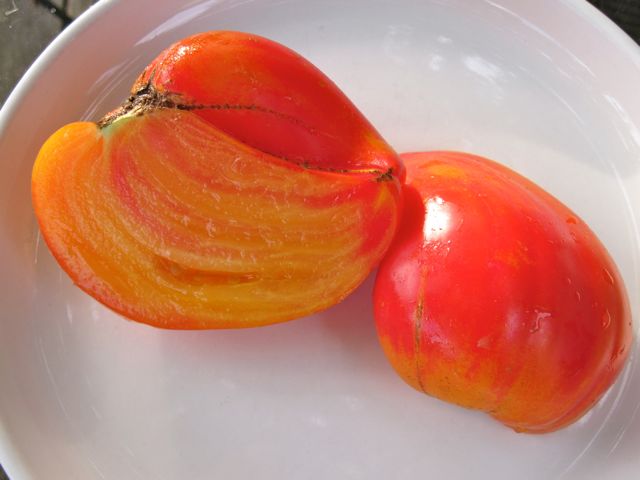
reference-image, l
(post, Linda Ziedrich)
While last summer’s blackened tomato vines still hang on their bamboo trellises, the seed catalogs are starting to arrive in my mailbox. Before I get absorbed in dreams of next year’s crop, I need to take stock of this year’s successes and failures. It’s time to update my running, year-by-year tomato report, which I’m writing with my friend Sally and sharing with whoever cares to read it. Because it seems unfair to judge a tomato variety that I’ve grown only in a year when summer never came (as happened here in western Oregon), I’ll reserve some judgments until next year. But there’s one find I want to share: the oxheart tomato. The oxheart isn’t a single variety; it’s a group of varieties with common characteristics and, apparently, common European breeding. Many have names like Orange Russian and Hungarian Heart. The vines are usually indeterminate — sprawling and continuously productive — and the foliage tends to be fern-like. Most of the available varieties are very old; none of them, as far as I’ve discovered, is a hybrid. [%image reference-image float=right width=400 caption="The Orange Russian."] But it’s the fruit you care about, right? Typically, it’s shaped like a heart or a strawberry, though individual tomatoes and some oxheart varieties may be round or oblong. The fruit tends to be big; Bull’s Heart is said to grow to 2 pounds and larger, and Giant to 3 pounds. And here’s what’s really important about these tomatoes: They are solid, meaty, with few seeds, and yet they are fairly acidic, juicy, and tasty. They are often described as fragrant. Cooks making salsa and tomato sauce, and especially tomato paste, are often advised to use dense-fleshed plum tomatoes such as Roma or San Marzano. Face it, though: These tomatoes taste bland and cottony, however local and organic they may be. What a joy to find a tomato that’s both meaty and delicious. Oxheart tomatoes are most often pinkish, but some varieties are tomato-red, orange, or yellow. Verna Orange is said to be the same color inside as a persimmon. And now there’s a bi-colored oxheart. Developed by Jeff Dawson of California, it’s a cross between Georgia Streak, a red-and-yellow beefsteak tomato, and the oxheart variety Russian 117. Dawson’s creation is called Orange Russian, and it’s my great tomato find of 2010. Unfortunately, I didn’t get a lot of fruits on my Orange Russian vines. In such a cold summer, of course, I got few tomatoes of any sort. But Mandy of Mandy’s Greenhouse, who grows quite a lot of oxheart varieties under cover in Manitoba, suggests that they generally aren’t very prolific. No matter; for next year I’ll choose a variety that is prolific, such as Anna’s Russian, an Oregon heirloom. And I’ll continue to plant Orange Russian, if only for its beautiful slices. p(blue). Culinate editor's note: This post also appeared on Linda Ziedrich's blog, A Gardener's Table.

reference-image, l